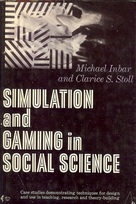SCHOLARLY BOOKS
Teaching Social Science Through Simulation

Simulation and Gaming in Social Science, co-authored with Michael Inbar.
New York: Free Press, 1971. For several years we directed the Academic Games Project at the Center for Study of Schools at Johns Hopkins University. We also started the journal Simulation and Gaming, which is still being published. Our project designed and tested social science simulations to teach complex processes to junior and senior high school students. Our mentor was James S. Coleman, a brilliant researcher and incisive critic.
Simulation and Gaming for Social Studies Teachers, co-authored with Samuel Livingston.
New York: Free Press, 1973. Skip was a games designer for the project and creator of a game included in this book. He developed the idea for this guidebook for school teachers to create their own games.
Download this article to learn more about this project.
The Early Days of Simulation and Gaming: An Early Reflection." Simulation and Gaming, 1995, No.4, 511 ff.
New York: Free Press, 1971. For several years we directed the Academic Games Project at the Center for Study of Schools at Johns Hopkins University. We also started the journal Simulation and Gaming, which is still being published. Our project designed and tested social science simulations to teach complex processes to junior and senior high school students. Our mentor was James S. Coleman, a brilliant researcher and incisive critic.
Simulation and Gaming for Social Studies Teachers, co-authored with Samuel Livingston.
New York: Free Press, 1973. Skip was a games designer for the project and creator of a game included in this book. He developed the idea for this guidebook for school teachers to create their own games.
Download this article to learn more about this project.
The Early Days of Simulation and Gaming: An Early Reflection." Simulation and Gaming, 1995, No.4, 511 ff.
Gender in Society

Sexism: Scientific Debates.
Reading, MA: Addison-Wesley, 1973. I started teaching about gender roles upon my arrival at Sonoma State University. The women's liberation movement was heating up, and my women students demanded this material. This was the first reader for college courses on the topic.
Female and Male: Socialization, Social Roles, and Social Structure.
Dubuque, IA: Wm. C. Brown, 1974, Revised 1977. As far as I know, this was the first textbook on gender roles in sociology. It reflected my position that to understand women's place in society, one had to also examine men's situation. In that sense, I broke with the early Women's Studies focus, which usually omitted comparable male activities, rituals, and expectations.
Reading, MA: Addison-Wesley, 1973. I started teaching about gender roles upon my arrival at Sonoma State University. The women's liberation movement was heating up, and my women students demanded this material. This was the first reader for college courses on the topic.
Female and Male: Socialization, Social Roles, and Social Structure.
Dubuque, IA: Wm. C. Brown, 1974, Revised 1977. As far as I know, this was the first textbook on gender roles in sociology. It reflected my position that to understand women's place in society, one had to also examine men's situation. In that sense, I broke with the early Women's Studies focus, which usually omitted comparable male activities, rituals, and expectations.
Social Inequality in America

The American Nightmare: Why Inequality Persists.
New York: Schocken, 1981. This was the result of a year's postdoctoral study on African-American history at Brown University. I explored what changes had occurred for women and blacks since the onset of the Johnson-era Civil Rights laws. The result was "not a lot." Though we've seen some gains since then, particularly with the rise of a black middle class and improved female employment opportunities, the continued inequitable incarceration rates and underemployment of African American men reminds us that patterns continue today.
The Social Control of Deviance: A Critical Perspective, co-authored with Nanette Davis.
New York: Random House, 1989. Nanette and I had long crossed paths at professional meetings and shared a similar view of deviant behavior as something that needed to be placed in a historical context, and interpreted from the viewpoint of Critical Theory with its emphasis upon power relations. We incorporated Europeans Michel Foucault and Jurgen Habermas over the more traditional views of Robert Merton and Howard Becker. This textbook demonstrates how governmental and economic actors may encourage crime and deviance as part of maintaining their power.
New York: Schocken, 1981. This was the result of a year's postdoctoral study on African-American history at Brown University. I explored what changes had occurred for women and blacks since the onset of the Johnson-era Civil Rights laws. The result was "not a lot." Though we've seen some gains since then, particularly with the rise of a black middle class and improved female employment opportunities, the continued inequitable incarceration rates and underemployment of African American men reminds us that patterns continue today.
The Social Control of Deviance: A Critical Perspective, co-authored with Nanette Davis.
New York: Random House, 1989. Nanette and I had long crossed paths at professional meetings and shared a similar view of deviant behavior as something that needed to be placed in a historical context, and interpreted from the viewpoint of Critical Theory with its emphasis upon power relations. We incorporated Europeans Michel Foucault and Jurgen Habermas over the more traditional views of Robert Merton and Howard Becker. This textbook demonstrates how governmental and economic actors may encourage crime and deviance as part of maintaining their power.